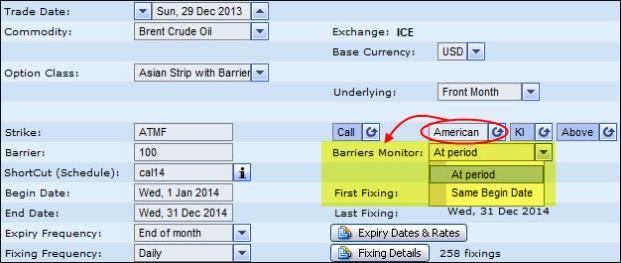
An Asian strip with barrier (abs) is a regular Asian Strip with the addition of a barrier, which can be European or American.
If you add a European barrier, then for each underlying Asian in the strip, the barrier can only be hit on the Asian's expiry date.
If you add an American barrier, then for each underlying Asian in the strip, the barrier must be hit in the relevant barrier window. There are two options for defining the barrier windows, as follows:
Each Asian's barrier window is automatically set to the duration of that Asian.
For each underlying Asian in the strip, its barrier window (as seen in the Expiry Dates & Rates window which you access by clicking the Expiry Dates & Rates button in the Single Option page or the Expiry Details button in the Portfolio page) is automatically set by the system to the lifetime of that Asian itself, i.e., it matches the Asian's start and end dates (and currently cannot be edited).
As each barrier window is only active for a single Asian, each Asian necessarily stands alone. So if its barrier is hit, that action does not affect any of the following Asians in the strip.
Each Asian's barrier window barrier begins on the start date of the first Asian in the strip.
For each Asian in the strip, its barrier window (as seen in the Expiry Dates & Rates window which you access by clicking the Expiry Dates & Rates button in the Single Option page or the Expiry Details button in the Portfolio page) is automatically defined by the system as follows–its start date is set to the start date of the first Asian in the strip, and its end date is set to the actual Asian's end date.
Accordingly, as there is overlap between the barrier windows, if a barrier is hit, it affects not only the current Asian, but all the following Asians in the strip (as their barrier windows are also active at the same time).
You set the monitoring type using the Barriers Monitor dropdown list which is only displayed after you set the barrier type to American (as seen in See "Selecting a Monitoring Type Using the Barriers Monitor Dropdown List "). If you want:
Each Asian's barrier window to be set to the duration of that Asian, choose At Period.
Each Asian's barrier window barrier to begin on the start date of the first Asian in the strip, choose Same Begin Date.

Figure 1: Selecting a Monitoring Type Using the Barriers Monitor Dropdown List
Why add a barrier?
You would add a barrier because of both of the following reasons combined:
Adding a barrier makes it cheaper than the equivalent Asian. This is because it has a risk of being knocked out, or of not being knocked in.
You have a particular view on the movement of the barrier's underlying that makes the risk of the added barrier worthwhile.
Pricing an Asian strip with barrier in SDX Commodities & Energy
When pricing an Asian strip with barrier (abs) note the following:
For an American barrier, the barrier window's start date cannot be prior to the instrument's trade date; the barrier window's end date cannot be after the instrument's expiry date.
It is essential to define not only the type of barrier (i.e., knock IN or knock OUT) but also the direction of the barrier (Above or Below). This is because the definition of this instrument is such that the barrier is triggered if the spot trades “at or beyond” the barrier level at any point during the monitoring period. Accordingly the barrier is considered triggered even if the spot rate is already beyond the barrier level in the monitoring period and never actually crosses the level during this period.